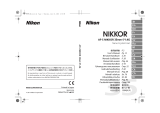
12
En
Usable cameras and available
functions
There may be some restrictions or limitation for available
functions. Refer to camera's User's Manual for details.
Cameras
Autofocus
Exposure mode
P
*1
6$0
D3-Series, D700, D2-Series, D1-Series, D300,
D200, D100, D90, D80, D70-Series, D60,
D50, D40-Series
33333
F6, F5, F100, F80-Series/N80-Series*,
F75-Series/N75-Series*, F65-Series/N65-Series*,
Pronea 600i/6i*, Pronea S*
2
3 3333
F4-Series, F90X/N90s*, F90-Series/N90*,
F70-Series/N70*
333
——
F60-Series/N60*, F55-Series/N55-Series*,
F50-Series/N50*, F-401x/N5005*,
F-401s/N4004s*, F-401/N4004*
—
3333
F-801s/N8008s*, F-801/N8008*,
F-601M/N6000*
—
33
——
F3AF, F-601/N6006*, F-501/N2020**,
Nikon MF cameras (except F-601
M/N6000*)
—————
3: Possible
—
: Impossible
*: Sold exclusively in the USA
**: Sold exclusively in the USA and Canada
*1: P includes AUTO and Vari-Program System.
*2: Manual (M) is not available.
Thank you for purchasing the AF-S NIKKOR 50mm f/1.4G lens. Before using this lens, please
read these instructions and refer to your camera's User's Manual.
Major features
•
This lens employs a Silent Wave Motor to drive the
focusing mechanism, making autofocusing smooth,
silent and almost instantaneous. The focus mode
switch ! is provided for simple selection of
autofocus (A) or manual focus (M) operation.
• More accurate exposure control is possible when
this is mounted on a Nikon camera with 3D
color matrix metering capability, because subject
distance information is transferred from the lens
to the camera.
• The rounded aperture produces soft and
pleasing blur characteristics in portions of
pictures that are out-of-focus.
• The closest focusing distance possible is 0.45 m
(1.5 ft.)
Important
• When mounted on Nikon digital SLR (Nikon DX
format) cameras, such as the D300 and D90, the
lens’ picture angle becomes 31°30’ and its 35mm
equivalent focal length is approx. 75 mm.









